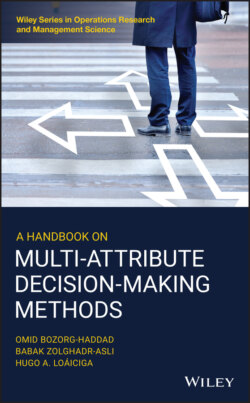Читать книгу A Handbook on Multi-Attribute Decision-Making Methods - Omid Bozorg-Haddad - Страница 19
2.2 The Weighted Sum Method
ОглавлениеThe weighted sum method (WSM), also referred to as the simple additive weighting (SAW) method, is the best known and simplest MADM method for evaluating a number of alternatives in terms of a number of decision criteria. The basic logic of WSM, which was perhaps the first logical solution that enabled the decision‐makers to cope with the MADM problems, is to obtain a weighted sum of the performance values of each alternative's overall attributes. Churchman and Ackoff (1954) were among the first to employ the WSM method to cope with a portfolio selection problem (Tzeng and Huang 2011). Ever since, due to the simplistic nature of the method, it quickly became a popular tool to cope with a MADM problem (Zanakis et al. 1995, 1998). Notable examples of applying WSM in different fields would be in agroecosystem management (Andrews and Carroll 2001), airlines' strategic planning and management (Chang and Yeh 2001), energy planning and management (San Cristóbal 2011), construction management (Jato‐Espino et al. 2014), environmental assessments (Kang 2002; Zhou et al. 2006), forestry management (Howard 1991), industrial management (Ma et al. 1999), industrial robot selection (Athawale and Chakraborty 2011), landfill site selection (Şener et al. 2006), mobile network selection (Savitha and Chandrasekar 2011), software evaluation (Olson et al. 1995), wastewater management (Zarghami 2011), and water supply planning (Goicoechea et al. 1992; Hobbs et al. 1992), to name a few.
The following is a detailed stepwise instruction to implement WSM as an MADM solving method:
